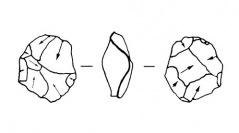

 Comptes Rendus Palevol
12 (5) - Pages 305-325
Comptes Rendus Palevol
12 (5) - Pages 305-325The Middle Stratigraphical Complex of the Caune de l’Arago cave site (Eastern Pyrenées, France) is dated to between 690,000 and 400,000 years old. The site contains successive, spatially distinct archaeological levels. At the base of the sequence, Unit I (OIS 14), where the P levels are among the earliest Mode 2 assemblages presently known in western Europe, contains finely shaped handaxes and a cleaver. Situated above this ensemble, Unit II (OIS 13) has revealed a series of artefact levels lacking handaxes and cleavers. Coiffing the sequence, Unit III (OIS12) has provided numerically rich faunal and lithic assemblages in association with Homo heidelbergensis remains. This paper analyses the stone industries from each artefact level taking into account raw material variability and highlights subtle technological and typological differences. This intrasite study uses a multidisciplinary approach to examine common elements and differences between levels, taking into consideration how external impact factors might have influenced global assemblage features. The Caune de l’Arago's long stratigraphical sequence provides an exceptional opportunity to observe both change and stability in Mode 2 stone-tool manufacture over a period spanning nearly 300,000 years, within the context of contrasting paleoenvironmental conditions.
Caune de l’Arago, Middle Pleistocene, Technology, Typology, Knapping, Mode 2, Acheulian